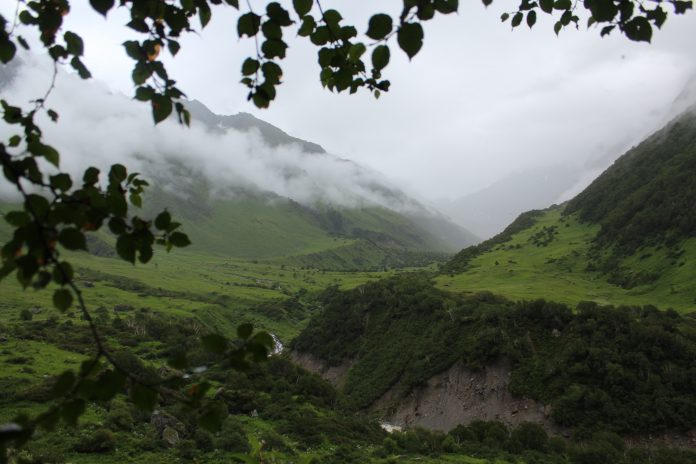The Valley of Flowers, also known as Phoolon Ki Ghati in Uttarakhand, is one of Uttarakhand’s most beautiful and fascinating locations, nestled peacefully in the West Himalayan region. The Valley of Flowers, which spans an area of 87 square kilometres in Uttarakhand’s Chamoli District, is set against the breathtaking backdrop of the spectacular Himalayan peaks. This place, discovered by legendary mountaineer Frank S Smith on his way back from an expedition to Mount Kamet in 1931, is nothing short of perfection on earth. This bouquet from nature features verdant meadows brimming with native alpine flowers. As a result, make sure to include the Valley of Flowers Trek in your Uttarakhand vacation itinerary.
Since 2013, when I saw some amazing photos on a friend’s phone, I’ve had a great urge to visit the “valley of flowers.” But I had no idea how to organise the trip or who to take with me.
Unexpectedly, my friend buzzed me one day, stating they were planning a walk to The Valley of Flowers. But, as a result of being absorbed in the daily hustle and bustle of life and professional commitments, the invitation received a disappointed “NO.” However, as a curious nature lover, I was enticed by this prospect.
This entire walk was a fantastic experience for me. I had planned to visit the Valley of Flowers, but I discovered that this tour would also include a visit to Hemkund Sahib. While at the office, I performed some research on the spot about places to visit. It was my first distance outing with the squad, and I didn’t know anyone who was participating.
The Team was introduced to me. We waited for the other slot to arrive, which took about an hour. Our planners had reserved two tempo travellers for a total of 26 passengers. We seated on our separate travellers to begin the journey after a few formalities.
We left for Joshimath, which was our next stop. It took me around nine hours to get there. I was enthralled by the serene beauty of the road leading to Joshimath as I gazed out the window. The whole natural diaspora’s flora and animals reminded me of William Wordsworth’s poetry. It was an incredible adventure that took us through the magnificent Panch Prayags, mighty mountains, and harrowing roads all the way to Joshimath. It was a thrilling experience to see the Himalayas for the first time. We came to a halt twice or three times for breakfast, lunch, and snacks.
I noticed a few Tata Sumos on the road, but learned that they usually only travel 3 kilometres to a single settlement. We all began walking slowly as we acclimatised to the hike, and we covered a three-kilometer motorable stretch. The trail then narrowed, and we began to climb large stretches of upward, followed by minor but inconsequential descents.
The road was mostly flat with some downhill sections. We arrived at the Laxman Ganga’s bank after a few hours of walking, where we took pictures and had a nice time.
We resumed our journey towards Ghangria, which was becoming increasingly difficult. My legs hurt and I felt like I couldn’t lift them any longer, but my enthusiasm kept me going. We were rapidly gaining altitude, and after over 10 kilometres, I noticed a significant drop in temperature, and it began to rain. Thank goodness we had been recommended to bring a raincoat, which came in handy. At 6:30 p.m., after much huffing and struggling, we arrived at Ghangria’s helipad.
Because of the unpredictability of the weather, it took us a half hour to walk from the helipad to Ghangria. It took me over 9 hours to finish the incredible drive from Joshimath to Ghangaria, including a few stops for tea, snacks, and, of course, serene photography.
Sikhs regard Hemkund Sahib to be a pilgrimage site, and a Gurudwara can be found at a height of 14500 feet. It is reached by a 6-kilometer trek that is extremely difficult. We awoke around 05:30 a.m., hurriedly showered, ate breakfast, and carried lunch provided by Unbelievable Living. We started at 7:30 a.m., and the trail is truly steep, with no flat surfaces to be found. Because the weather was clear and I could see the trail’s magnificence, I decided to ride a little faster. I was hoping to be in Hemkund Sahib as soon as possible. I had seen some beautiful photos and didn’t want to miss out on all of the views from the top, so I planned to spend some time at the lake.
Aside from the valley, the dense verdant forests, the Pushpawati river, snow-capped mountains, steep cliffs, pristine glaciers, and tumbling waterfalls provide for a spectacular sight. If you enjoy photography, bird watching, trekking, and village walks, this location will appeal to you. The valley is home to endangered animals such as the Asiatic black bear, musk deer, snow leopard, red fox, brown bear, and blue sheep, in addition to its rich and diverse flora. It’s no surprise that this chocolate box site is both an Indian National Park and a UNESCO World Heritage Site, making it one of Uttarakhand’s most popular tourist destinations.
Things To Do:
Trek:
It’s an excellent place for trekking and mountaineering because it’s located in the transitional zone between the magnificent Zanskar mountains and the eastern and western Himalayas. Govindghat, a village, is the starting point for the 17-kilometer trip. The trail is surrounded by breathtaking vistas of rushing waterfalls, deep forest, and the Himalayan peaks. Ghangaria, 14 kilometres from Govindghat, is the destination. It’s a little hamlet and the last human settlement on the approach to Uttarakhand’s Valley of Flowers National Park.
Pilgrims:
Sri Hemkund Sahib Gurudwara literally translates to “lake of snow” and is located at an elevation of 4,329 metres. To go to the Sikh temple at Hemkund Sahib and the Valley of Flowers in Uttarakhand, pilgrims employ porters, mules, or helicopters. It is one of the most sacred temples in the Himalayas, and the Sikh community holds it in high regard. The crystal-clear Hemkund Lake is flanked by seven ice cap peaks and provides a breathtaking mirror of the gorgeous mountain ranges and enthralling glaciers, making the walk to Uttarakhand’s Valley of Flowers even more rewarding.
It is a peaceful, serene, and beautiful location that draws pilgrims and tourists from all over the world. It’s no surprise that it was formerly used for meditation by Indian yogis and the tenth Guru, Guru Gobind Sahib. Aside from that, this location has a unique significance for Hindus. According to legend, Hanuman brought the mystical herb to resurrect Lakshman in the Valley of Flowers, as portrayed in the epic Ramayana. Many people think that the miraculous plant ‘Sanjeevani’ still flourishes in the Valley of Flowers.
Village Walks:
Before reaching the Valley of Flowers, you’ll pass through Ghangaria, the last human settlement on your journey. It is also the meeting point of the Hemganga and the Pushpawati Rivers, which was formerly known as the Lakshman Ganga. While it is covered in snow for the majority of the year, it is recommended that you visit between May and September. However, once you see this lovely and serene village, your arduous hiking will be well worth it. It’s a fantastic spot for trekking, village walks, or simply witnessing nature and wildness in its purest form.
Species Of Flowers:
The Valley of Flowers is Uttarakhand’s hidden gem, and just seeing it will make you fall in love with nature and its beauty. You will find yourself in a natural baroque of flowers with over 650 types of flowers such as orchids, saxifrages, blue poppy, sediams, lilies, calendula, Geranium, marigold, Himalayan rose daisies, river anemone, primulas, zinnia, and petunia. Perhaps this is why the place has been designated as a “Centre of Plant Diversity.” Aside from that, you’ll see a variety of vibrant butterflies flitting among the vibrant flowers.
Himalayan Birds:
The Valley of Flowers will be a treat for everyone interested in bird watching! This region is home to a variety of foreign species as well as Indian Himalayan birds, including the Himalayan golden eagle, Himalayan snowcock, snow partridge, snow pigeon, Himalayan monal, and sparrow.
Best Time To Visit:
The Valley of Flowers in Uttarakhand is only accessible between June and October, and the best time to visit is between July and mid-August when it is in full bloom. Here’s what you can expect over the next few months:
Month Of June:
You can see little buds and sprouts that will soon grow into colourful and bright flowers when the snow melts and the seeds of the previous year’s plants begin to germinate. In June, you can see flowers such as Reinwardtia Indica, Oxalis Corniculata, Viola Pilosa, Fragaria Nubicola, Thymus Linearis, Wild Rose, Berberis Aristata, Gagea Lutea, and Marsh Marigold in the Valley of Flowers.
Month Of July:
During this time, you may see one of Uttarakhand’s most stunning sceneries. You’ll be able to wander across a blanket of flowers of all kinds, including massive collections of Epilobium. As a result, July is the finest month to explore Uttarakhand’s Valley of Flowers.
Month Of August:
The Valley of Flowers blooms magnificently until mid-August, and you may see a variety of flowers and butterflies throughout this time, not to mention the spectacular scenery and breathtaking views. If you’re going on a journey, though, July to September is the greatest time to go. The first monsoon rains had stopped at this point. As a result, when organising your adventure activities, you won’t have to worry about the weather. Having said that, it is best to avoid visiting the Valley of Flowers in Uttarakhand during the winter months because the beautiful and verdant meadows are fully blanketed in snow, defeating the point of your visit.
The Valley of Flowers is more than a visual treat; it’s also a UNESCO World Heritage Site and the meeting point of the Western and Eastern Himalayan peaks. We are fortunate enough to observe a piece of heaven right here on Earth. With its gleaming white glaciers, snow-capped peaks, gushing waterfalls, and serene lakes, it wouldn’t be a stretch to claim that Uttarakhand’s Full Ki Ghati is the epitome of bliss!












